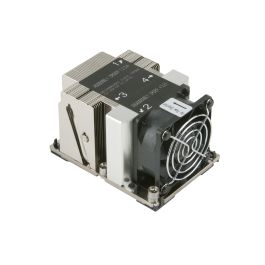Thomas_VDB
Contributor
- Joined
- Sep 22, 2012
- Messages
- 102
Hi,
I am replacing a iXsystems TrueNAS core server (6 years old) that we are using as iSCSI storage for 2 ESXi-hosts.
The new quotation from iXsystems is pretty expensive. That's why we 're thinking of building it ourself.
We need similar or better specs. Requirements haven't changed. The old server is still performing well.
Old server :
- Neptune iX2112 : 2U 12 bay LFF - 1200W redundant (1+1) PSU
- Intel Xeon E5-1620 v3@ 3.5GHz
- 32GB DDR4 2133Mhz 17000 ECC/REG
- 10x Hitachi 3TB Ultrastar Enterprise SAS 6Gb/s 7200RPM 64MB Cache (1 big tank in mirroring)
- ZIL : Samsung 128GB 850 Pro Series Solid State Drive (MLC) MZ-7KE128BW
- L2ARC : Samsung 256GB 850 Pro Series Solid State Drive (MLC)
- OS : 32GB SATADOM MLC
- 1x PCIe : 2 port 10GbE SFP+
My budget is around 5k€.
First we were thinking going all-flash, but with enterprise NVME our budget is too tight.
Then I thought of building it with a HP Proliant DL380 Gen10 12x LFF bay.
However the built-in drive/raid controller (P408i) isn't the best option for TrueNAS.
Edit : I think the Supermicro SSG-620P-ACR12L seems a better option over the HP. It has an IT-mode card.
Can you guys give me some suggestions? HP proliant or SuperMicro?
Would WD Gold HD's be good?
Which SSD's for ZIL/ARC? And better up the RAM?
Thx.
I am replacing a iXsystems TrueNAS core server (6 years old) that we are using as iSCSI storage for 2 ESXi-hosts.
The new quotation from iXsystems is pretty expensive. That's why we 're thinking of building it ourself.
We need similar or better specs. Requirements haven't changed. The old server is still performing well.
Old server :
- Neptune iX2112 : 2U 12 bay LFF - 1200W redundant (1+1) PSU
- Intel Xeon E5-1620 v3@ 3.5GHz
- 32GB DDR4 2133Mhz 17000 ECC/REG
- 10x Hitachi 3TB Ultrastar Enterprise SAS 6Gb/s 7200RPM 64MB Cache (1 big tank in mirroring)
- ZIL : Samsung 128GB 850 Pro Series Solid State Drive (MLC) MZ-7KE128BW
- L2ARC : Samsung 256GB 850 Pro Series Solid State Drive (MLC)
- OS : 32GB SATADOM MLC
- 1x PCIe : 2 port 10GbE SFP+
My budget is around 5k€.
First we were thinking going all-flash, but with enterprise NVME our budget is too tight.
Then I thought of building it with a HP Proliant DL380 Gen10 12x LFF bay.
However the built-in drive/raid controller (P408i) isn't the best option for TrueNAS.
Edit : I think the Supermicro SSG-620P-ACR12L seems a better option over the HP. It has an IT-mode card.
Can you guys give me some suggestions? HP proliant or SuperMicro?
Would WD Gold HD's be good?
Which SSD's for ZIL/ARC? And better up the RAM?
Thx.
Last edited:

